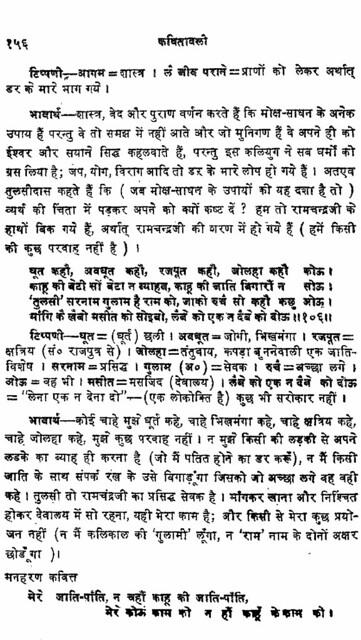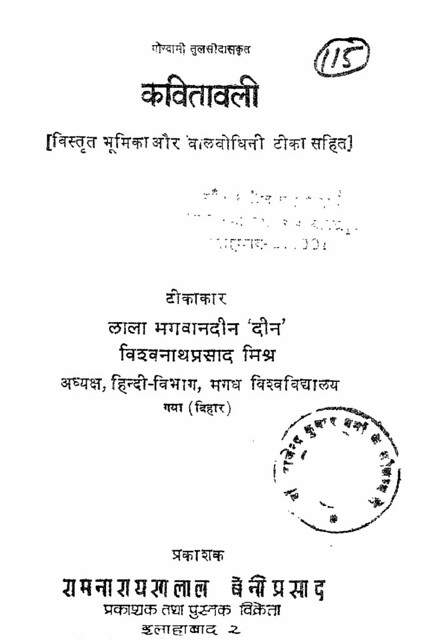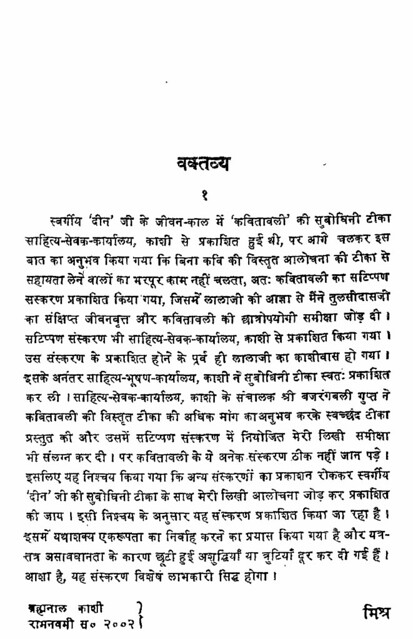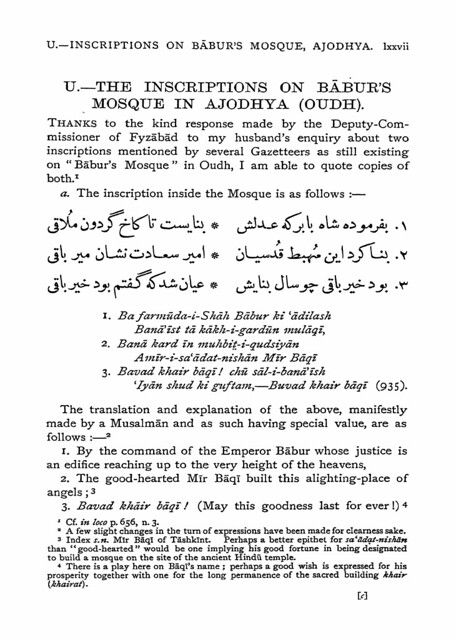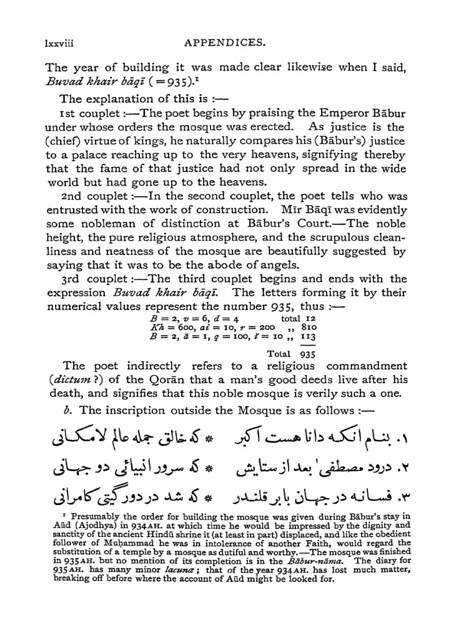x-posted from GD
Next Expert Witness examined in the court and considered by HC is PW16 Sri Suraj Bhan
J Sudhir Aggarwal
Vol 15
Pages 3604- 9 105/251 OF THE vol) Para 3608-
http://www.rjbm.nic.in/sa/Judgment%20RJ ... Vol-15.pdf
3608. PW-16 Sri Suraj Bhan, a Professor in the Ancient Indian Archaeological Department of Kurukshetra University, Rohtak, has deposed that according to his research, no evidence he could find whereupon it could be said that the Babari Mosque was constructed after demolition of a temple. He is co author of document, Exhibit 62 (Suit-4) (also Exhibit 45, Suit 5; Register 32 Page 231) which is a letter said to be prepared by four historians, namely, Dr. R.S. Sharma, M. Athar, Sri D.N. Jha and PW 16. He claims that the archaeological part in the said document was written by him.
Some would remember that this letter was also published in The Hindu and other News Papers
3609. Exhibit 45 (Suit-5) (Register 32 Page 231) is a photocopy of a booklet claimed to be written by R.S. Sharma, M. Athar Ali, D.N. Jha and Suraj Bhan titled as “Babari Mosque or Rama's Birth Place? Historians Report to the Indian Nation” dated 13th May 1991. This document has been heavily relied by the plaintiffs (Suit-4) in support of the submissions that neither the site in dispute was ever believed to be the birthplace of Lord Rama nor there existed any temple which was demolished to construct building in dispute.Itsrelevant extract is:( I am giving only relevant extracted extract
"Introduction
For the last two years a furious agitation has been organised in this country under the aegis of the Vishwa Hindu Parishad and its allies over what has come to be known as the Ram Janambhumi-Baburi Masjid Dispute.Precious lives have been lost, communal riots have brokenout, and for the first time since independence the secular nature of our State has come under serious threat, all
seemingly over the issue of what is to be done to a 16thcentury structure at Ayodhya.
<snip>
However, in spite of these obstacles, we thought that national interest required an unbiased and impartial inquiry, so that people should be clear about what the historical facts are. We scrutinised most carefully the evidence submitted to Government by the VHP and BMAC, and collected historical material on our own. Two of us went to Ayodhya to examine and survey the site and the structure of the Baburi Masjid.
<snip>
The VHP's case rests on the following four major claims:
(1) The Hindus have always, and certainly over a long period before the construction of the Baburi Masjid, believed in there being a very sacred spot at Ayodhya, where Lord Rama was born.
(2) This spot was the very site where the Baburi Masjid now stands.
(3) A temple dedicated to Rama stood at this holy site long before the Baburi Masjid was built.
(4) The temple was pulled down to construct the Baburi Masjid at this spot.
<snip>
Within fifty years or so of the construction of the Baburi Masjid, Tulsidas composed in 1575-76 his celebrated Ramcharitmanas, the most fervent exposition of the Ramayna story in Hindi. Is it possible to believe that Tulsidas would not have given vent to heartrending grief had the very birth site of his Lord been ravaged, its temple razed to the ground and a mosque erected at that place? Surely he could not but have known of the event, had the desecration and temple-destruction taken place in 1528-29,
early in his life but long before the composition of his work. Knowing of it would be not have complained in his verses that fate (if anything else) was now preventing Rama's devotees from worshipping the very sacred seat of the Lord's birth? His silence can only mean that he knew of no such scandal; and, given his attachment to Rama and Ayodhya, this must then mean that no such event had infact taken place.
Tulsidas, on the contrary, suggests that it was not Ayodhya but Prayag that was to him the principal place of pilgrimage (tirath Raj); and so no tradition of the veneration of the any spot as that of Rama's birth at Ayodhya had yet taken shape.
<snip>
We have thus a reference to where Rama's ashes were buried, which, as we have seen from the Skanda Purana, as deemed of principal importance as svarga duara, but there is no reference to where Rama was born. We are told of “the ruins of the castle” (Ramkot) extensive enough for a search for gold to be undertaken, but not of any exact site of special veneration within that castle' – let alone a temple site desecrated by a mosque.
<snip>
Thus until two hundred and twenty years after the construction of the Baburi Masjid, there was no suggestion anywhere, in the long contemporary inscriptions of the mosque or any other description of Ayodhya that there was a precise site of Rama's birth, where the holy structure had been destroyed and the mosque built – whether we take the writings of Hindus or of Muslims or the record left by single European observer."
<snip>
No work by a daughter of Bahadur Shah or bearing the title Sahifa-i Chihal Nasa-i Bahadur Shah is known to exist in any collection anywhere in the world.
<snip>
While in his so called quotation from the Counsels of the Mughal princess Mirza Jan only speaks of a temple at the site of Sita-ki-rasoi being destroyed he goes on himself to say that the Baburi Masjid was built at Rama's birthplace by destroying the temple of Ram Janamsthan, close to Sita-ki-Rasoi, so that the mosque, was then known as Sita-ki-rasoi. Thus the legent had grown to Rama's birth site had been added Sita's kitchen; and Mirza Jan was exulting in the the supposed destruction of a temple here, of which generations of earlier Hindus and Muslims were unaware.
<snip>
Subsequent to Mirza Jan's tract – in fact, subsequent to the clash over the Baburi Masjid in 1855 – the myth that the Masjid was built on the site of a destroyed temple became the common possession of the partisans of the two communities
<snip>
The conclusion that we have reached after a careful consideration of the entire available evidence may be summarised as follows:-
1. No evidence exists in the texts that before the 16th century (and indeed before the 18th century), any veneration attached to any spot in Ayodhya for being the birth-site of Rama.
2. There are no grounds for supposing that a Rama temple, or any temple, existed at the site where Baburi Masjid was built in 1528-29. This conclusion rests on an examination of the archeological evidence as well as the contemporary inscriptions on the mosque.
3. The legend that the Baburi Masjid occupied the site of Rama's birth did not arise until late 18th century; that the temple was destroyed to build a mosque was not asserted until the beginning of the 19th century, when the observer, before whom the assertion was made, disbelieved it
.
4. The full blown legend of the destruction of a temple at the site of Rama's birth and Sita-ki-rasoi, is as late as the 1850's. Since then what we get is merely the progressive reconstruction of imagined history based on faith. It is for the people of this country to judge whether on the basis of such dubious evidence as the VHP has presented in support of its case, it is justifiable to mortgage
the destiny and good repute of the country. As historians it is also our duty to point out that in no civilised country of the world is a building of the 16th century permitted to be destroyed or tempered with.
In 1891 when a Fuhrer drew up his descriptive list of Antiquities and Inscription in the North-West Provinces and Oudh, 1891, he put the Baburi Masjid among the monuments of Class II (P.P. 296-7). On page i, he explained the implications of this classification; it meant that though the monument was “in possession of private bodies and individuals”, it was possible or desirable to
save (it) from further decay by such minor measures as the eradication of vegetation, the exclusion of water from the wells and the like”. Being such a monument, the Baburi Masjid became a protected monument under the Ancient Monuments Act, 1904 (re-legislated, 1958). Besides being built nearly 450 years ago, it is a significant example of Sharqi architecture. It is a part of our common national heritage. Under law, Government must save and preserve it as a fully protected monument.
If then, we have a care for historical facts, if we want to uphold the law, if we have love for our cultural heritage, we must protect Baburi Masjid. A country is surely judged by how it treats its past."
3611. Prof. R.S. Sharma, Retired Professor of Delhi University and First Chairman of Indian of Indian Council of Historical Research; Prof. M. Athar Ali, Retired Professor of History of Aligarh Muslim University and the Former President of Indian History Congress; Prof. D.N. Jha, Professor of History, Delhi University; Prof. Suraj Bhan, Professor of Archaeology and Dean, Faculty of Social Sciences, Kurukshetra University, Haryana. This document, though claimed to be written by four historians, but as a matter of fact, it was not signed by Sri D.N. Jha, as admitted by Sri Suraj Bhan (PW 16), as expert witness.
PW 16 Sri Suraj Bhan was examined and here is the result of his examination as expert witness over the Document purpotedly prepared by him with three others and released to Media and relied upon by Sunni Waqf Board in their case.
3612. PW 16, Prof. Suraj Bhan was examined in three phases, namely, from 22.02.2000 to 10.08.2000; thereafter when
the book of T.P. Verma and S.P. Gupta, i.e., “Ayodhya Ka Itihas Evam Puratatva-Rigved Kal Se Ab Tak” (Exhibit 3, Suit-5) was published, he deposed statement from 26.08.2002 to 12.09.2002 and lastly after the ASI report he deposed statement to castigate it and his statement was recorded from 20.03.2006 to 28.03.2006.
SO here are his statements/depositions
“I got my graduation degree from Delhi University. In graduation, my subjects were Economics and Sanskrit besides English and Hindi.
History was not my subject in B.A. . . . . I did my
M.A. in Sanskrit from Delhi and later in
archaeology and culture from M.S. University Baroda.”
“After completion of my studies up to M.A. I did nothing for one year. Thereafter I went to Baroda and joined a post in the Archaeological Survey of India. I did my M.A. in archaeology in and around 1960. I had obtained my degree while being in service there. Thereafter I got my Ph.D. I had started service in 1956 and I got my M.A. in 1960. I was conferred Ph.D. Degree in 1975. My
topic in
Ph.D. was ‘Historic Archaeology of Saraswati and Drishdavati Valleys’.”
“
My Ph.D. Thesis is not published.” (pages 13); “I had not undertaken any excavation work in Saraswati Valley at the time of writing my thesis. This excavation work in Saraswati Valley, however, was done by me before proceeding with the thesis.. . . . . I had
a prior experience of excavation work because I had undertaken such work at Lothal and Bhagatrao in Gujarat.” (E.T.C.)
“At the time of excavation in the Saraswati region of Haryana, I undertook archaeological excavation. I did both the area and vertical excavation.” (E.T.C.)
“
I am an M.A. in Sanskrit language. I can not speak Sanskrit, and since I have not used it for quite some time, I face difficulty in reading as also in following it.”; “I did my B.A. in 1953. Sanskrit and Economics were my subjects in B.A.. English literature, too, was my subject.. . . . I
did not study history and archaeology as subjects up to B.A.. I passed the M.A.Examination with Sanskrit and also with Archaeology and Culture.. . . . I only remember that
ancient history and early medieval history were not in my course.
The said two parts of history was of India only.”
I
am a field archaeologist and as such can use field archaeology wherever it can be used in any sphere of archaeology.. . . .“ Field archaeology has a basic method . . . . . . and I am well conversant with that field.” (E.T.C.)
“I have not studied Vedas wholly; rather, I have studied them only to the extent they were included in the curriculum of my study.” (page 4); “I know a little about Puranas.” (page 7); “I have not read Vishnu Purana.” (page

; “I have read some portions of Valmiki's
Ramayana.” (page 15);“I have not done any research on whether Lanka of Valmiki's Ramayana may or may not be in Madhya Pradesh.” (page 16); “I do not have any specific knowledge of directions on the basis of the solar system. I did not make any special study on this subject. . . . .I have not read Vishnu Purana.” (page 18); “I have not read Rajshekhar's 'Balramayana'.. . . .As a
historian too, I did not try to know what is written in the Ramayana by Tulsi Das.” (page 19);
“I have not read logic.” (page 20); “
I cannot tell when Indus valley was discovered. It is a subject of Geography.” (page 33) (E.T.C.)
“I have knowledge of post-Qutbuddin muslim history but not in its minute details; I do not have any study on it.” (page 42);
“I did not read what features a mosque may not have.” (page 75); “I am not a specialist in epigraphy and numismatics.” (page 82) (E.T.C.)
“Since
construction of mosques after demolishing temples is not the subject of my research, so I did not make an endeavour to make study of those places. Otherwise also, I am
not a historian with regard to medieval period.”
Likewise, I
did not read Tulsidas's Ramacharit Manas and Valmiki's Ramayana in entirety.
“But it is true that I am not a specialist in history.” (page 169); “I
did not do any research work after making excavations in Uttar Pradesh. I did
not make any excavation in Bihar.” (page 170); “I
did not do any research work with respect to ancient archaeological buildings, nor did I write a book in this respect.” (page179)
“I am
not a geologist. . . . . I am
not a student of History.” (page 26); “I am
not a specialist in architecture. I
have an ordinary knowledge of it.” (page 36); “I am
not a specialist in sculpture.” (page 51); “
Epigraphy, too, is not my field.” (page 57);
“My speciality was field archaeology, not ethnography.” (page 71): “I am
not a specialist in history of temple architecture.” (page 122)
(E.T.C.)
3615.
The following part of his statement is relevant to ascertain sincerity, genuineness and correctness in the alleged
research of the witness and his statement: (
HC observes)
"Only Sharma and myself had gone to Ayodhya at time of Ayodhya research." (ETC)
“I gave this report in May. I might have gone to Ayodhya in February-March."
“Article(s) written by me, R.A. Sharma, D.N.Jha and Atahar Ali and other evidences were produced in the 13- 05-1991 meeting by Babri Masjid Committee on behalf of Babri Masjid. Further stated, our report had not possibly been prepared on behalf of Babri Masjid Committee. Rather our opinion was quoted in their arguments.” (ETC)
“ Out of the four impartial historians,
two of us had not gone to Ayodhya and Banaras with us. I do not know whether they had gone to Ayodhya or Banaras separately or not." (ETC)
“we were
given only six weeks' time for the entire study.
Pressure was being repeatedly exerted; so, we submitted our report without going through the record of the excavation work by B.B.Lal." (ETC)
Note: This part of the statement is in contradiction to what has been said by PW 13 at page 199. “It is true that constructions going on a particular time are influenced by the circumstances prevailing at that time. As a historian I have seen a mosque in Benares
which is built by demolishing a temple to half its size."(ETC)
"Sri D.N.Jha is a scholar in regard to ancient Indian history. The knowledge of Prof.R.S. Sharma is fairly extensive. He is a specialist in socio-economic history." (ETC)
“I
did not make any study of any recorded history with regard to the disputed subject" (ETC)
“
I did not make any excavation at the site, nor was it a part of my investigation." (ETC)
"Recorded history, too, was not my subject, nor am I its specialist. I am also not a specialist in art history but I have general understanding of it.” (ETC)
3616. Later on,
the witness could not tell as to in which category of specialist he is appearing:
“it is true that I am not a specialist in history. I do not know that my testimony in this litigation has been only as an archaeologist." (ETC)
So you feel surprised.Here is an expert who has authored a report on the Issue used in the case of Plaintiff in Suit 4 and 5.He claims that he is not a historian, has difficulty in speaking and reading sanskrit ( his subject in MA) has done some excavation , written an unpublished thesis, does not know ancient or medieval history, has not read Ramcharit manas and Ramayana, recorded history is not his forte, admits that he has seen a mosque in Benara which was constructed by demolishing a temple and the admits having prepared a report under pressure. He is an archeologist, a field archeologist but does not know when Indus valley was discovered and says it is a matter of Geography, as if he is talking of discovery of a Volcano by National geographic. How much reliance should be placed on his deposition.
You are not alone in this surprise. HC has some scathing words for them But later.

